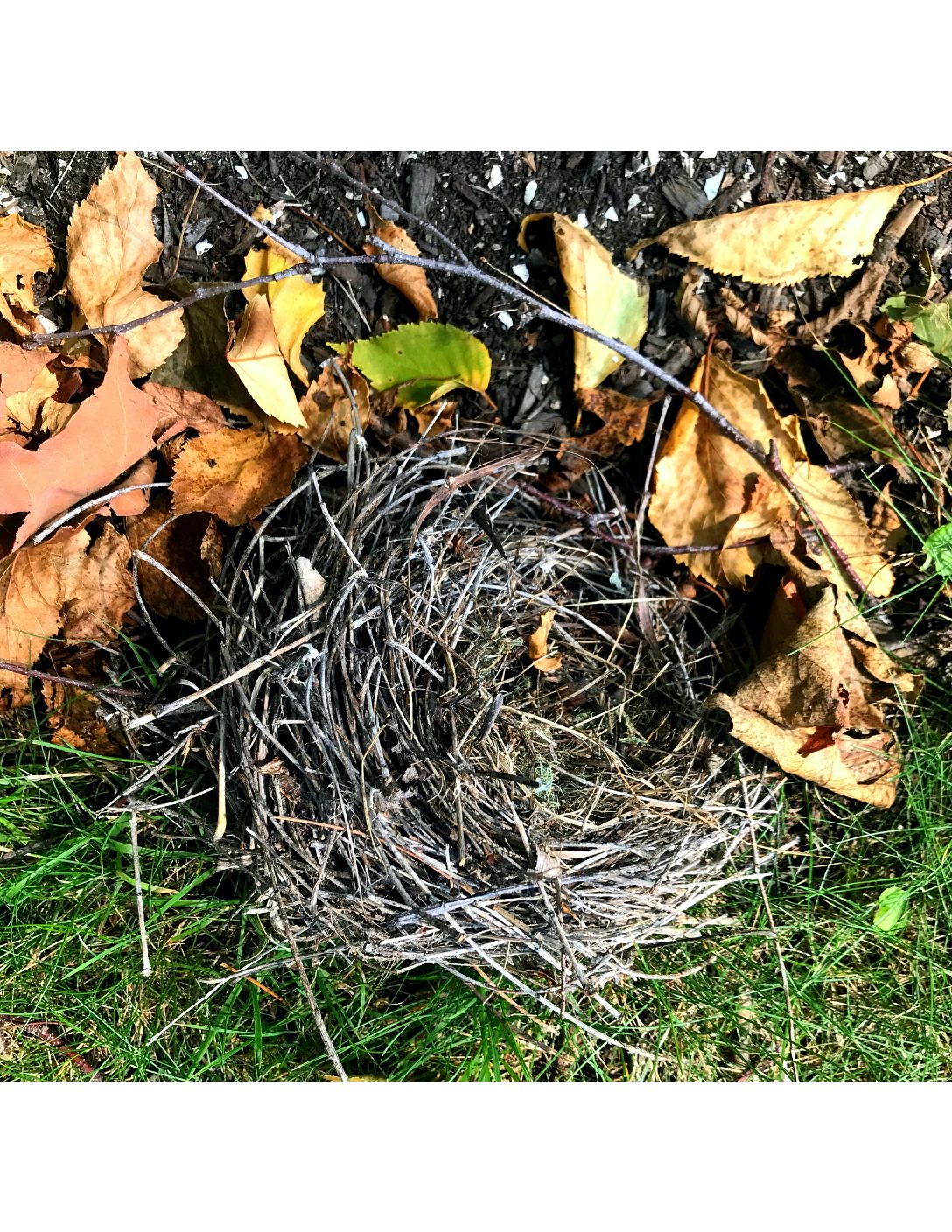On a Fallen Nest
I almost didn’t notice it, crossing up the yard to the house for lunch. Had I not stopped to catch my breath, I’d have missed it entirely. There, on the edge of the August-dry garden, a perfect nest.
I knelt to lift it into my hand. Bird architecture is so delicate and deliberate: a grass and lichen cylinder woven in intricate symmetry by a beak. This one had to be a yellow-belly sapsucker’s, for it was shallow and almost weightless. It probably held only one egg, by now a full-fledged and lusty youth busily seeking old apple trees to bore with that same able beak to attract the insects it needs to survive.
The nest was, as all nests are, beautiful as it was. Maybe not the Martha Stewart of nests, but it was the one to which the next generation would return next mating season, and for seasons to come. The way the swallows return to the bird house up the hill. The way the deer return to the same river and the same patch of green, to graze and raise their young.
It must have been blown from the tree by the fierce storm that raised tornados here a few weeks ago. Walking through town, we’d witnessed that damage: roofs crushed by massive oaks, evergreens snapped in two. One man had filled three-acres with logs from all that had been torn up and hurled back down.
This was a quieter rupture, but maybe sadder for this fact.
These days, it can feel as if nature has abandoned us. A virus brought the world to its knees. Fires in the West are devouring the landscape. In lockdown, many of us have come to value more keenly the small, and humble perfections: our children and families, close friends, the rhythms of the nature we see around us. We’ve learned the migrations patterns of birds we hardly noticed before, come to recognize the songs of those who grace our telephone lines and yards. The hiding places of the toads, and the footprints of the night stars have helped us keep time even though the score of life’s general symphony has been temporarily lost.
Those things we believed we could rely on, however simple and humble, had the power to lift us from hopelessness to grateful trust, each day.
We have tried not to demand too much of one another.
We have tried to be kinder, more generous, more trusting. More open and patient.
Sometimes, however, for reasons we can’t comprehend, this proves not enough.
Nests aren’t returned to. Easy rhythms of relationship become bumpy and unbalanced, and it is difficult to know how to restore them. We are left out, or turned away from. What we believed turns out not to be true. Trust is tested to the breaking point, and unspeakable disappointment lingers.
These, our human storms, are more painful than any tornado. But they are also the only ones we can heal from and repair.
The day after the big storm that took out so many trees and felled power lines, our world was very quiet. A kind of apocalyptic calm settled — exactly the calm that settled on my city in March, as the shock of lockdown began. The same quiet that befalls a wounded heart.
The next day, however, the roads were noisy — with utility trucks, bucket trucks, men in neon gear operating chain saws, holding up traffic signs to regulate drivers who ventured out. All of the resources the region had to bear were sent out to restore things to normal.
Electrical crews, slow and purposeful as vascular surgeons, reattached fallen lines, traced power gaps back to junction boxes. Piece by piece, the grid — surely, one of our human nests — was put back together. By the end of the day, all the clocks and laptops worked again.
The repair of damaged hearts or disordered relationships isn’t as easy, of course. But the steps are the same: to acknowledge and absorb the reality of the hurt, and then to move into the damaged places with purpose and a willingness to work, restoring the threads of connection, piece by gentle piece.
The fallen nest will remain on the ground, and the sapsucker will construct a new one next year. We humans, for whom the true nests are our closest relationships, have much to learn from birds in stormy seasons, about the beautiful and delicate symmetry the heart requires.
It may help if we can all remember the beloved words of Isaiah 43: 19
Behold, I will do a new thing; now it shall spring forth; shall ye not know it? I will even make a way in the wilderness, and rivers in the desert.
Namaste.





Kathie M
September 13, 2020at9:39 amBeautiful, thoughtful insights here Kathy. Thanks for sharing!
Kathleen Hirsch
September 13, 2020at10:55 amThank you, friend. So nice to hear from you!
mary meader
September 13, 2020at8:30 amthank you Kathleen. A gift from a wise Sister…,beautiful heart-filled words and images from a faithful soul. An unexpected and much needed uplifting gift begin this Sabbath morning.
Kathleen Hirsch
September 13, 2020at9:13 amMy dear Mary,
I have learned so much from you, it is an honor to know that this has touched you. We need to dig deep to reach the well. Blessings
Sue O’Reilly
September 13, 2020at7:58 amI am just a little too young to know this but these times seem analogous to the World War II years—A time of staggering hardships and loss, fighting a named “enemy”, praying that an end will come but knowing that the battle is still long and must be endured, and knowing that we will not be going back to the world we once knew. Perhaps there are hopes and lessons from those demanding times eighty years ago.for us today.
Kathleen Hirsch
September 13, 2020at9:12 amSue, this is such a Wise reference. Those who forget history are doomed to repeat it. Forget who said this, but it’s so true. Really good to hear from you.